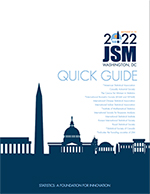Back
2022 Joint Statistical Meetings
Section on Statistics in Epidemiology
Session: Contributed Poster Presentations: Section on Statistics in Epidemiology
COVID-19, Climate, and Socioeconomic Status in the United States: A Bayesian Analysis of County-Level Case Data
Tuesday, August 9, 2022
Activity Number: 289
-
Jordan Bramble
University of Kansas
SARS-CoV-2 has infected over 96 million people in the United States. Its spread is heterogeneous, and differences may be partially explained by temporal and spatial variations in environmental and socioeconomic variables. Literature suggests that temperature and humidity may impact SARS-CoV-2 spread, but their influence remains unclear. Similar is true of population density, poverty, race, ethnicity, and age. Meanwhile, literature suggests that air pollution may increase spread. We utilize SIR models with county-dependent parameters to simulate SARS-CoV-2 spread acrossthe U.S. Transmission rates are assumed to evolve temporally according to a stationary log-AR(1) process. These models are fit to county-level COVID-19 case data, and parameter estimates for all U.S. counties are obtained via Markov chain Monte Carlo sampling. We analyze the above variables’ relative influence on SARS-CoV-2 transmission using a Bayesian linear regression model with the estimated means of county-level transmission rates as the response and environmental and socioeconomic variables as covariates. Results indicate that environmental and socioeconomic variables significantly impact SARS-CoV-2 transmission.

